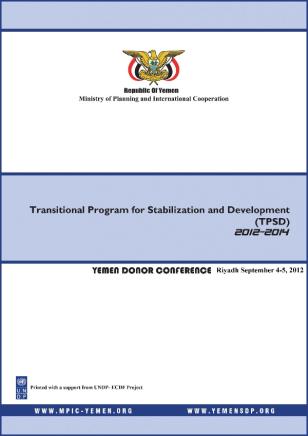Transitional Program for Stabilization and Development (TPSD) 2012-2014
Transitional Program for Stabilization and Development (TPSD) 2012-2014
July 14, 2013
Yemen is classified as the poorest country in the Middle East and North Africa region. During the last few years the Yemeni economy faced a range of successive crises and urgent challenges leading to the aggravation of poverty and food insecurity. As a result and during the year 2011, Yemen saw a continuous popular uprising in different governorates claiming for the change of the regime resulting in acute deterioration of the political scene, loss of security and partial destruction of the infrastructure, and hence aggravating an already bad situation. Consequently, the economic and livelihood situation of the majority of the population deteriorated in a critical and unprecedented
manner.
Following the escalation of violence in the country during 2011, the UN Security Council adopted its resolution (2014) on 21 October 2011 which called different parties for immediate engagement and cessation of violence. A Gulf Cooperation Council’s brokered agreement that is accompanied with an implementation mechanism was signed on 23 November 2011, and is since being implemented. In the face of such challenges, and as a result of the GCC sponsored transition agreement, a Government of National Reconciliation was formed.
The GCC implementation mechanism supporting the transition calls for a Government of National Reconciliation entrusted with formulating and implementing an initial program of economic stabilization and development that addresses the immediate needs of the population in all regions of Yemen.
This program was developed, entitled “The Transitional Program for Stabilization and Development TPSD” and is presented in this paper. As seen in the paper implementing this program cannot be achieved under a “business as usual” process. Transition has its own rules and so does the fluid situation that we have now in Yemen. Hence, the need for innovative, swift, and flexible approaches cannot be under estimated.

 Locations
Locations





